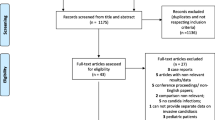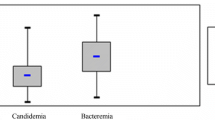Abstract
Background
Candidemia is a life-threatening infection in the ICU whose prognosis is highly dependent on the stage at which it is recognized. Procalcitonin (PCT) levels have been shown to accurately distinguish between bacteremia and noninfectious inflammatory states in critically ill patients with clinical signs of sepsis. Little is known about the accuracy of PCT for the diagnosis of candidemia in this setting.
Setting
A medical intensive care unit in a teaching hospital.
Patients and methods
Review of the medical records of every non-neutropenic patient with either bacteremia or candidemia and clinical sepsis in whom PCT dosage at the onset of infection was available between May 2004 and December 2005.
Results
Fifty episodes of either bacteremia (n = 35) or candidemia (n = 15) were included. PCT levels were found to be markedly higher in patients with bacteremia than in those with candidemia. Moreover, a low PCT value was found to be an independent predictor of candidemia in the study population. According to the calculation of the area under the receiver operating characteristic curve, PCT was found to be accurate in distinguishing between candidemia and bacteremia (0.96 [0.03]). A PCT level of higher than 5.5 ng/ml yields a 100% negative predictive value and a 65.2% positive predictive value for candidemia-related sepsis.
Conclusion
A high PCT value in a critically ill non-neutropenic patient with clinical sepsis is unlikely in the setting of candidemia.


Similar content being viewed by others
References
Morgan J, Meltzer MI, Plikaytis BD, Sofair AN, Huie-White S, Wilcox S, Harrison LH, Seaberg EC, Hajjeh RA, Teutsch SM (2005) Excess mortality, hospital stay, and cost due to candidemia: a case-control study using data from population-based candidemia surveillance. Infect Control Hosp Epidemiol 26:540–547
Charles PE, Doise JM, Quenot JP, Aube H, Dalle F, Chavanet P, Milesi N, Aho LS, Portier H, Blettery B (2003) Candidemia in critically ill patients: difference of outcome between medical and surgical patients. Intensive Care Med 29:2162–2169
Nolla-Salas J, Sitges-Serra A, Leon-Gil C, Martinez-Gonzalez J, Leon-Regidor MA, Ibanez-Lucia P, Torres-Rodriguez JM (1997) Candidemia in non-neutropenic critically ill patients: analysis of prognostic factors and assessment of systemic antifungal therapy. Study group of fungal infection in the ICU. Intensive Care Med 23:23–30
Charles PE, Dalle F, Aube H, Doise JM, Quenot JP, Aho LS, Chavanet P, Blettery B (2005) Candida spp. colonization significance in critically ill medical patients: a prospective study. Intensive Care Med 31:393–400
Charles PE (2006) Multifocal candida species colonization as a trigger for early antifungal therapy in critically ill patients: what about other risk factors for fungal infection? Crit Care Med 34:913–914
Wahyuningsih R, Freisleben HJ, Sonntag HG, Schnitzler P (2000) Simple and rapid detection of candida albicans DNA in serum by PCR for diagnosis of invasive candidiasis. J Clin Microbiol 38:3016–3021
Ugarte H, Silva E, Mercan D, De Mendonca A, Vincent JL (1999) Procalcitonin used as a marker of infection in the intensive care unit. Crit Care Med 27:498–504
Harbarth S, Holeckova K, Froidevaux C, Pittet D, Ricou B, Grau GE, Vadas L, Pugin J (2001) Diagnostic value of procalcitonin, interleukin-6, and interleukin-8 in critically ill patients admitted with suspected sepsis. Am J Respir Crit Care Med 164:396–402
Huber W, Schweigart U, Bottermann P (1997) Failure of PCT to indicate severe fungal infection in two immunodeficient patients. Infection 25:377–378
Christofilopoulou S, Charvalos E, Petrikkos G (2002) Could procalcitonin be a predictive biological marker in systemic fungal infections? Study of 14 cases. Eur J Intern Med 13:493–495
Dornbusch HJ, Strenger V, Kerbl R, Lackner H, Schwinger W, Sovinz P, Urban C (2005) Procalcitonin–a marker of invasive fungal infection? Support Care Cancer 13:343–346
Svaldi M, Hirber J, Lanthaler AI, Mayr O, Faes S, Peer E, Mitterer M (2001) Procalcitonin-reduced sensitivity and specificity in heavily leucopenic and immunosuppressed patients. Br J Haematol 115:53–57
Williams RL (2000) A note on robust variance estimation for cluster-correlated data. Biometrics 56:645–646
Muller B, Becker KL, Schachinger H, Rickenbacher PR, Huber PR, Zimmerli W, Ritz R (2000) Calcitonin precursors are reliable markers of sepsis in a medical intensive care unit. Crit Care Med 28:977–983
Chirouze C, Schuhmacher H, Rabaud C, Gil H, Khayat N, Estavoyer JM, May T, Hoen B (2002) Low serum procalcitonin level accurately predicts the absence of bacteremia in adult patients with acute fever. Clin Infect Dis 35:156–161
von Lilienfeld-Toal M, Dietrich MP, Glasmacher A, Lehmann L, Breig P, Hahn C, Schmidt-Wolf IG, Marklein G, Schroeder S, Stuber F (2004) Markers of bacteremia in febrile neutropenic patients with hematological malignancies: procalcitonin and IL-6 are more reliable than c-reactive protein. Eur J Clin Microbiol Infect Dis 23:539–544
Clec’h C, Ferriere F, Karoubi P, Fosse JP, Cupa M, Hoang P, Cohen Y (2004) Diagnostic and prognostic value of procalcitonin in patients with septic shock. Crit Care Med 32:1166–1169
Pugin J (2002) Biomarkers of sepsis: is procalcitonin ready for prime time? Intensive Care Med 28:1203–1204
Christ-Crain M, Muller B (2005) Procalcitonin in bacterial infections – hype, hope, more or less? Swiss Med Wkly 135:451–460
Distefano G, Curreri R, Betta P, Romeo MG, Amato M (2004) Procalcitonin serum levels in perinatal bacterial and fungal infection of preterm infants. Acta Paediatr 93:216–219
Petrikkos GL, Christofilopoulou SA, Tentolouris NK, Charvalos EA, Kosmidis CJ, Daikos GL (2005) Value of measuring serum procalcitonin, c-reactive protein, and mannan antigens to distinguish fungal from bacterial infections. Eur J Clin Microbiol Infect Dis 24:272–275
Eloy O, Vauloup C, Therond P, Pina P, Allouch P, Pangon B, Bedos JP, Ghnassia JC (2001) Procalcitonin level in deep-seated Candida infections. Ann Biol Clin (Paris) 59:502–505
Giamarellos-Bourboulis EJ, Mega A, Grecka P, Scarpa N, Koratzanis G, Thomopoulos G, Giamarellou H (2002) Procalcitonin: a marker to clearly differentiate systemic inflammatory response syndrome and sepsis in the critically ill patient? Intensive Care Med 28:1351–1356
Nijsten MW, Olinga P, The TH, de Vries EG, Koops HS, Groothuis GM, Limburg PC, ten Duis HJ, Moshage H, Hoekstra HJ, Bijzet J, Zwaveling JH (2000) Procalcitonin behaves as a fast responding acute phase protein in vivo and in vitro. Crit Care Med 28:458–461
Tavares E, Maldonado R, Ojeda ML, Minano FJ (2005) Circulating inflammatory mediators during start of fever in differential diagnosis of gram-negative and gram-positive infections in leukopenic rats. Clin Diagn Lab Immunol 12:1085–1093
Linscheid P, Seboek D, Schaer DJ, Zulewski H, Keller U, Muller B (2004) Expression and secretion of procalcitonin and calcitonin gene-related peptide by adherent monocytes and by macrophage-activated adipocytes. Crit Care Med 32:1715–1721
Astiz M, Saha D, Lustbader D, Lin R, Rackow E (1996) Monocyte response to bacterial toxins, expression of cell surface receptors, and release of anti-inflammatory cytokines during sepsis. J Lab Clin Med 128:594–600
Meisner M, Tschaikowsky K, Hutzler A, Schick C, Schuttler J (1998) Postoperative plasma concentrations of procalcitonin after different types of surgery. Intensive Care Med 24:680–684
Clec’h C, Fosse JP, Karoubi P, Vincent F, Chouahi I, Hamza L, Cupa M, Cohen Y (2006) Differential diagnostic value of procalcitonin in surgical and medical patients with septic shock. Crit Care Med 34:102–107
Author information
Authors and Affiliations
Corresponding author
Rights and permissions
About this article
Cite this article
Charles, P.E., Dalle, F., Aho, S. et al. Serum procalcitonin measurement contribution to the early diagnosis of candidemia in critically ill patients. Intensive Care Med 32, 1577–1583 (2006). https://doi.org/10.1007/s00134-006-0306-3
Received:
Accepted:
Published:
Issue Date:
DOI: https://doi.org/10.1007/s00134-006-0306-3




